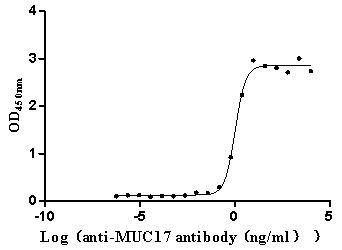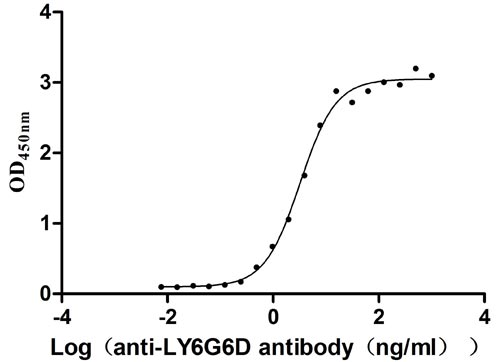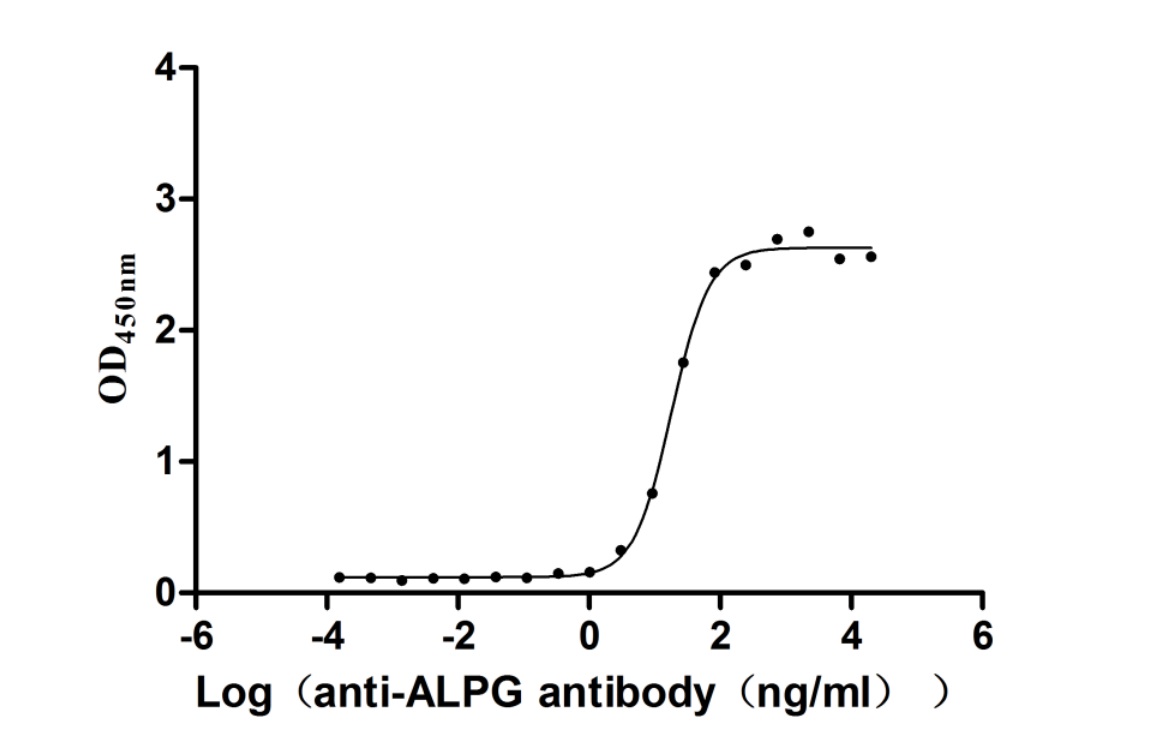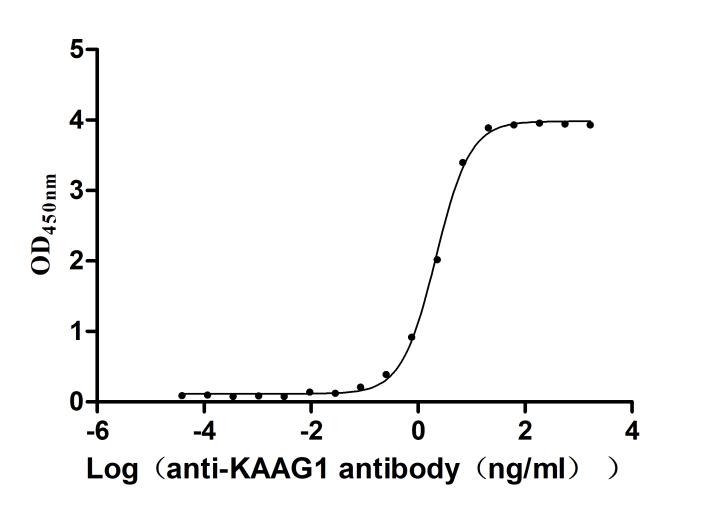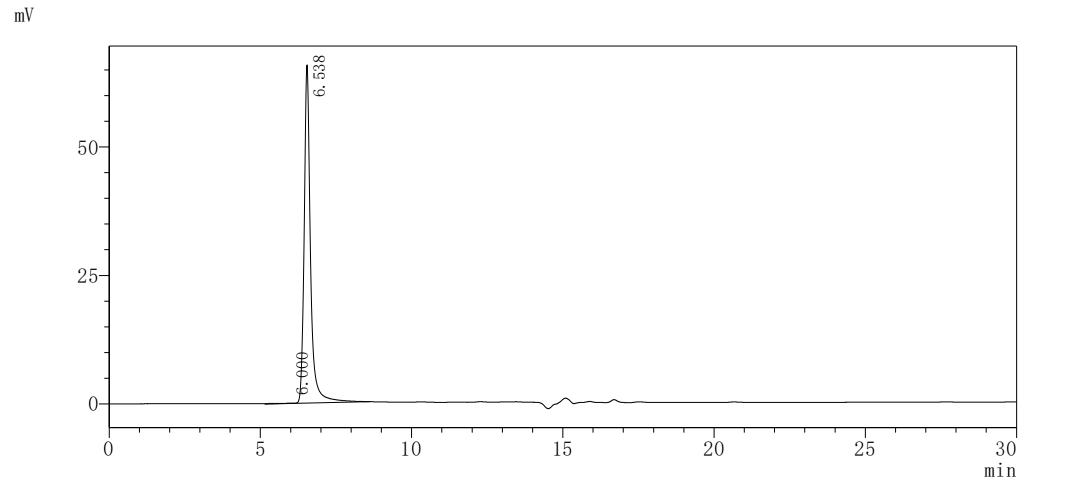Recombinant Mouse Protein kinase C alpha type (Prkca)
-
中文名称:小鼠Prkca重组蛋白
-
货号:CSB-YP018699MO
-
规格:
-
来源:Yeast
-
其他:
-
中文名称:小鼠Prkca重组蛋白
-
货号:CSB-EP018699MO
-
规格:
-
来源:E.coli
-
其他:
-
中文名称:小鼠Prkca重组蛋白
-
货号:CSB-EP018699MO-B
-
规格:
-
来源:E.coli
-
共轭:Avi-tag Biotinylated
E. coli biotin ligase (BirA) is highly specific in covalently attaching biotin to the 15 amino acid AviTag peptide. This recombinant protein was biotinylated in vivo by AviTag-BirA technology, which method is BriA catalyzes amide linkage between the biotin and the specific lysine of the AviTag.
-
其他:
-
中文名称:小鼠Prkca重组蛋白
-
货号:CSB-BP018699MO
-
规格:
-
来源:Baculovirus
-
其他:
-
中文名称:小鼠Prkca重组蛋白
-
货号:CSB-MP018699MO
-
规格:
-
来源:Mammalian cell
-
其他:
产品详情
-
纯度:>85% (SDS-PAGE)
-
基因名:
-
Uniprot No.:
-
别名:Prkca; PkcaProtein kinase C alpha type; PKC-A; PKC-alpha; EC 2.7.11.13
-
种属:Mus musculus (Mouse)
-
蛋白长度:Full Length of Mature Protein
-
表达区域:2-672
-
氨基酸序列ADVYPANDS TASQDVANRF ARKGALRQKN VHEVKDHKFI ARFFKQPTFC SHCTDFIWGF GKQGFQCQVC CFVVHKRCHE FVTFSCPGAD KGPDTDDPRS KHKFKIHTYG SPTFCDHCGS LLYGLIHQGM KCDTCDMNVH KQCVINDPSL CGMDHTEKRG RIYLKAEVTD EKLHVTVRDA KNLIPMDPNG LSDPYVKLKL IPDPKNESKQ KTKTIRSNLN PQWNESFTFK LKPSDKDRRL SVEIWDWDRT TRNDFMGSLS FGVSELMKMP ASGWYKAHNQ EEGEYYNVPI PEGDEEGNME LRQKFEKAKL GPVGNKVISP SEDRKQPSNN LDRVKLTDFN FLMVLGKGSF GKVMLADRKG TEELYAIKIL KKDVVIQDDD VECTMVEKRV LALLDKPPFL TQLHSCFQTV DRLYFVMEYV NGGDLMYHIQ QVGKFKEPQA VFYAAEISIG LFFLHKRGII YRDLKLNNVM LNSEGHIKIA DFGMCKEHMM DGVTTRTFCG TPDYIAPEII AYQPYGKSVD WWAYGVLLYE MLAGQPPFDG EDEDELFQSI MEHNVSYPKS LSKEAVSICK GLMTKQPAKR LGCGPEGERD VREHAFFRRI DWEKLENREI QPPFKPKVCG KGAENFDKFF TRGQPVLTPP DQLVIANIDQ SDFEGFSYVN PQFVHPILQS AV
-
蛋白标签:Tag type will be determined during the manufacturing process.
The tag type will be determined during production process. If you have specified tag type, please tell us and we will develop the specified tag preferentially. -
产品提供形式:Lyophilized powder
Note: We will preferentially ship the format that we have in stock, however, if you have any special requirement for the format, please remark your requirement when placing the order, we will prepare according to your demand. -
复溶:We recommend that this vial be briefly centrifuged prior to opening to bring the contents to the bottom. Please reconstitute protein in deionized sterile water to a concentration of 0.1-1.0 mg/mL.We recommend to add 5-50% of glycerol (final concentration) and aliquot for long-term storage at -20℃/-80℃. Our default final concentration of glycerol is 50%. Customers could use it as reference.
-
储存条件:Store at -20°C/-80°C upon receipt, aliquoting is necessary for mutiple use. Avoid repeated freeze-thaw cycles.
-
保质期:The shelf life is related to many factors, storage state, buffer ingredients, storage temperature and the stability of the protein itself.
Generally, the shelf life of liquid form is 6 months at -20°C/-80°C. The shelf life of lyophilized form is 12 months at -20°C/-80°C. -
货期:Delivery time may differ from different purchasing way or location, please kindly consult your local distributors for specific delivery time.Note: All of our proteins are default shipped with normal blue ice packs, if you request to ship with dry ice, please communicate with us in advance and extra fees will be charged.
-
注意事项:Repeated freezing and thawing is not recommended. Store working aliquots at 4°C for up to one week.
-
Datasheet :Please contact us to get it.
靶点详情
-
功能:Calcium-activated, phospholipid- and diacylglycerol (DAG)-dependent serine/threonine-protein kinase that is involved in positive and negative regulation of cell proliferation, apoptosis, differentiation, migration and adhesion, cardiac hypertrophy, angiogenesis, platelet function and inflammation, by directly phosphorylating targets such as RAF1, BCL2, CSPG4, TNNT2/CTNT, or activating signaling cascades involving MAPK1/3 (ERK1/2) and RAP1GAP. Depending on the cell type, is involved in cell proliferation and cell growth arrest by positive and negative regulation of the cell cycle. Can promote cell growth by phosphorylating and activating RAF1, which mediates the activation of the MAPK/ERK signaling cascade, and/or by up-regulating CDKN1A, which facilitates active cyclin-dependent kinase (CDK) complex formation. In cells stimulated by the phorbol ester PMA, can trigger a cell cycle arrest program which is associated with the accumulation of the hyper-phosphorylated growth-suppressive form of RB1 and induction of the CDK inhibitors CDKN1A and CDKN1B. Depending on the cell type, exhibits anti-apoptotic function and protects cells from apoptosis by suppressing the p53/TP53-mediated activation of IGFBP3, or mediates anti-apoptotic action by phosphorylating BCL2. During macrophage differentiation induced by macrophage colony-stimulating factor (CSF1), is translocated to the nucleus and is associated with macrophage development. After wounding, translocates from focal contacts to lamellipodia and participates in the modulation of desmosomal adhesion. Plays a role in cell motility by phosphorylating CSPG4, which induces association of CSPG4 with extensive lamellipodia at the cell periphery and polarization of the cell accompanied by increases in cell motility. During chemokine-induced CD4(+) T cell migration, phosphorylates CDC42-guanine exchange factor DOCK8 resulting in its dissociation from LRCH1 and the activation of GTPase CDC42. Negatively regulates myocardial contractility and positively regulates angiogenesis, platelet aggregation and thrombus formation in arteries. Mediates hypertrophic growth of neonatal cardiomyocytes, in part through a MAPK1/3 (ERK1/2)-dependent signaling pathway, and upon PMA treatment, is required to induce cardiomyocyte hypertrophy up to heart failure and death, by increasing protein synthesis, protein-DNA ratio and cell surface area. Regulates cardiomyocyte function by phosphorylating cardiac troponin T (TNNT2/CTNT), which induces significant reduction in actomyosin ATPase activity, myofilament calcium sensitivity and myocardial contractility. In angiogenesis, is required for full endothelial cell migration, adhesion to vitronectin (VTN), and vascular endothelial growth factor A (VEGFA)-dependent regulation of kinase activation and vascular tube formation. Involved in the stabilization of VEGFA mRNA at post-transcriptional level and mediates VEGFA-induced cell proliferation. In the regulation of calcium-induced platelet aggregation, mediates signals from the CD36/GP4 receptor for granule release, and activates the integrin heterodimer ITGA2B-ITGB3 through the RAP1GAP pathway for adhesion. During response to lipopolysaccharides (LPS), may regulate selective LPS-induced macrophage functions involved in host defense and inflammation. But in some inflammatory responses, may negatively regulate NF-kappa-B-induced genes, through IL1A-dependent induction of NF-kappa-B inhibitor alpha (NFKBIA/IKBA). Upon stimulation with 12-O-tetradecanoylphorbol-13-acetate (TPA), phosphorylates EIF4G1, which modulates EIF4G1 binding to MKNK1 and may be involved in the regulation of EIF4E phosphorylation. Phosphorylates KIT, leading to inhibition of KIT activity. Phosphorylates ATF2 which promotes cooperation between ATF2 and JUN, activating transcription. Phosphorylates SOCS2 at 'Ser-52' facilitating its ubiquitination and proteosomal degradation.
-
基因功能参考文献:
- Deleting the Prkca gene, which encodes PKCalpha, reverses diabetes-induced autophagy impairment, cellular organelle stress and apoptosis, leading to an NTD reduction. PKCalpha increases the expression of miR-129-2, which is a negative regulator of autophagy. miR-129-2 represses autophagy by directly targeting PGC-1alpha, a positive regulator for mitochondrial function, which is disturbed by maternal diabetes. PMID: 28474670
- Its pathway may promote reactive oxygen species generation in the early state Alzheimer's disease and eventually contribute to the exacerbation of pathological phenotype PMID: 29602494
- This indicates a role for PKC in dynamically controlling the trafficking of SNAT3 transporters in astrocytes in situ. PMID: 29561757
- Results show that de novo polarisation of the embryo at the 8-cell stage is directed by phospholipase C (PLC) and protein kinase C (PKC). PMID: 29030553
- protein kinase Calpha (PKCalpha) gain of function mutations may promote synaptic defects in Alzheimer's disease PMID: 27165780
- PKC-alpha plays a crucial role in the pathophysiology of peritoneal membrane dysfunction induced by peritoneal dialysis fluids, and its therapeutic inhibition might be a valuable treatment option for peritoneal dialysis patients. PMID: 27142955
- these results identify PKCalpha and HMGB1 as important co-regulators involved in hydrogen peroxide-induced poly-ADP-ribose formation. PMID: 27198223
- We conclude that synaptotagmin-1 phosphorylation is an essential step in PKC-dependent potentiation of synaptic transmission, acting downstream of the two other essential DAG/PKC substrates, Munc13-1 and Munc18-1. PMID: 27091977
- Kinocilium is essential for proper localization of Lgn, as well as Gai and aPKC, suggesting that cilium function plays a role in positioning of apical proteins critical for hearing. PMID: 26662512
- Social defeat-driven PKA activation in the basolateral amygdala is actually a compensatory rather than pathogenic response in the homeostasis. PMID: 26747511
- PKCalpha deficiency leads to pulmonary vascular hyperresponsiveness to TXA2, possibly via increased pulmonary arterial TP receptor expression. PMID: 26890419
- PKC gene deletion is responsible for hair loss. PMID: 26076315
- The overall result suggests the cancer preventive activity of quercetin via the induction of apoptosis and modulates PKC signaling with the reduction of oxidative stress in ascite cells of lymphoma-bearing mice. PMID: 26076811
- the ANG II-dependent upregulation of renin in the collecting duct depends on PKC-alpha, which allows the augmentation of cAMP production and activation of PKA/CREB pathway PMID: 26268270
- role for PKCalpha in the regulation of ECM structure and deposition during skin wound healing. PMID: 26354149
- A dynamic PKC phosphorylation/de-phosphorylation cycle of Munc18-1 drives short-term enhancement of transmitter release during post-tetanic potentiation. PMID: 24520164
- PKC-alpha and -delta have been shown to play crucial role in cardiac adaptation during physiological and pathological hypertrophy respectively thereby rendering compromised cardiac function to an otherwise efficient heart by conditional reversal of activation. PMID: 25116170
- Data show increased expression of T-type Ca(2+) current and association of protein kinase C alpha (PKCalpha) with caveolin-3 (Cav-3)was disrupted in the hypertrophic ventricular myocyte. PMID: 26170457
- These results suggest that mechanisms of PKC-induced hypersensitivity of TRPV1 are modality specific and that S800 is a polymodal sensitization site integrating multiple inflammatory signals in nociceptors. PMID: 25734989
- Protein kinase C phosphorylation of a Pcdhgc3c-terminal lipid binding domain regulates FAK inhibition and dendrite arborization. PMID: 26139604
- Protein kinase C alpha plays an important modulatory role in RBCs, regulating both the peak amplitude and temporal properties of the RBC light response in the rod visual pathway. PMID: 26230760
- These results demonstrate the importance of PKCbetaII in chronic lymphocytic leukemia-like disease progression and suggest a role for PKCalpha subversion in creating permissive conditions for leukemogenesis. PMID: 25616575
- The results of this study findings indicate that PKCdelta plays a role in mediating histamine-induced itch, but may be dispensable for chloroquine- and beta-alanine-induced itch PMID: 25558916
- Study demonstrates that PKCalpha, PKCdelta and PKCepsilon isoforms are differentially expressed in particular cellular components of pre-pubertal, pubertal and adult mouse ovarian follicles. PMID: 25491605
- regulates UT-A1 function by increasing glycan sialylation through Src kinase pathways PMID: 25300290
- PKC-alpha activation and interaction with F0F1-ATPase improves F0F1-ATPase activity and ATP content in injured renal cells. PMID: 25627689
- PKCalpha expression is associated with a delayed replacement of embryonic smooth muscle by skeletal muscle at the distal esophagus and consecutive megaesophagus PMID: 24862691
- These results suggest that mitochondrial APE1/Ref-1 is contributed to the protective role to protein kinase C-induced mitochondrial dysfunction in endothelial cells. PMID: 24861944
- PKC-alpha and -betaIotaIota are the predominant isoforms in the developing optic pathway, whereas PKC-epsilon is the major form in the chiasmatic neurons. PMID: 24863469
- Genetic ablation of PKCalpha preserves AQP2 and UT-A1 protein expression and localization in lithium-induced nephrogenic diabetes insipidus. PMID: 25006961
- contributes to high NaCl-dependent activation of NFAT5 through ERK1/2 PMID: 25391900
- These findings implicate PKCalpha as a target gene for therapeutic approaches in low bone mass conditions. PMID: 25070889
- In summary, our results indicate that cytoskeleton perturbation via PKCalpha and PKCdelta inactivation potentiates vascular calcification through osteogenic signal induction. PMID: 25445591
- Overexpressed PKCdelta downregulates the expression of PKCalpha in B16F10 melanoma. PMID: 24632809
- Stimulation by either PAF or ATP resulted in PKCalpha-mediated phosphorylation of LPCAT2 to enhance lyso-PAFAT activity and rapid PAF production. PMID: 24742674
- Polycystin-1 binds Par3/PKCalpha and controls convergent extension during renal tubular morphogenesis. PMID: 24153433
- Elevation of protein kinase Calpha stimulates osteogenic differentiation of mesenchymal stem cells. PMID: 24219286
- Identified a set of 22 alternative splicing events that undergo a developmental switch in splicing, and we confirmed that splicing reverts to an embryonic pattern in adult diabetic hearts. PKC isozymes alpha/beta control alternative splicing of these genes. PMID: 24151077
- Evaluated the effects of small interference RNA protein kinase C-alpha (siRNA-PKCalpha) on experimental proliferative vitreoretinopathy (PVR) induced by dispase in mice. PMID: 23626468
- Sirolimus-FKBP12.6 impairs endothelial barrier function by activation of protein kinase C-alpha and downstream disruption of the p120-VE cadherin interaction in vascular endothelium. PMID: 23887639
- Our findings indicate that PKCalpha and theta; contribute to T-cell activation with overlapping functions essential for graft-vs-host disease PMID: 23908466
- PAB induced cell cycle arrest, autophagy and senescence in murine fibrosarcoma L929 cell through Protein kinase C. PMID: 23630435
- PKCalpha and PKCbeta cooperate in IL-2 transcriptional transactivation in primary mouse T cells independently of the actions of PKCtheta;. PMID: 23439007
- PGE2-induced activation of angiogenesis is mediated via syndecan-4-dependent activation of PKCalpha. PMID: 23525101
- These results support the hypothesis that PKC-alpha and PKC-beta contribute to the pathogenesis of diabetic nephropathy, and that dual inhibition of the classical PKC isoforms is a suitable strategy for the prevention and treatment of diabetic nephropathy. PMID: 23434935
- This study aimed to investigate the functional and molecular changes of detrusor smooth muscle (DSM) in high-fat insulin resistant obese mice, focusing on the role of protein kinase C (PKC) and Ca(v)1.2 in causing bladder dysfunction. PMID: 23144896
- PKCalpha and Akt modulate platelet function by phosphorylating and inhibiting GSK3alpha/beta, thereby relieving the negative effect of GSK3alpha/beta on thrombin-mediated platelet activation. PMID: 23239877
- The elucidated signaling cascade explains how 5-HT(1A)-R regulates hippocampal sculpting and function, which may determine the affective phenotype of an adult. PMID: 22832728
- It was concluded that PKCalpha mediates hypertonicity-stimulated urea transport but is not necessary for vasopressin stimulation of urea permeability in mouse inner medullary collecting ducts. PMID: 23097465
- Follicle-stimulating hormone-induced activation of PKC alpha alone, or together with the inactivation of PKC betaI in granulosa cells, participates in mouse oocyte meiotic resumption. PMID: 23028752
显示更多
收起更多
-
相关疾病:Expression of the mutant form UV25 causes malignant transformation of cells.
-
亚细胞定位:Cytoplasm. Cell membrane; Peripheral membrane protein. Mitochondrion membrane; Peripheral membrane protein. Nucleus. Note=Translocated to the cell periphery upon tetradecanoyl phorbol acetate (TPA) treatment.
-
蛋白家族:Protein kinase superfamily, AGC Ser/Thr protein kinase family, PKC subfamily
-
数据库链接:
Most popular with customers
-
Recombinant Paguma larvata Angiotensin-converting enzyme 2 (ACE2), partial (Active)
Express system: Mammalian cell
Species: Paguma larvata (Masked palm civet)
-
Recombinant Human T-cell surface protein tactile (CD96), partial (Active)
Express system: Mammalian cell
Species: Homo sapiens (Human)
-
Recombinant Human Mucin-17 (MUC17), partial (Active)
Express system: Mammalian cell
Species: Homo sapiens (Human)
-
Recombinant Human Lymphocyte antigen 6 complex locus protein G6d (LY6G6D) (Active)
Express system: Yeast
Species: Homo sapiens (Human)
-
Recombinant Human Alkaline phosphatase, germ cell type (ALPG) (Active)
Express system: Mammalian cell
Species: Homo sapiens (Human)
-
Recombinant Human Cadherin-6(CDH6),partial (Active)
Express system: Mammalian cell
Species: Homo sapiens (Human)
-
Recombinant Human Kidney-associated antigen 1(KAAG1) (Active)
Express system: E.coli
Species: Homo sapiens (Human)
-
Recombinant Human C-C chemokine receptor type 9 (CCR9)-VLPs (Active)
Express system: Mammalian cell
Species: Homo sapiens (Human)


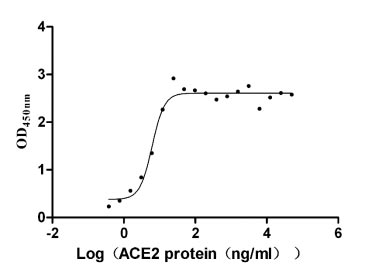
-AC1.jpg)
